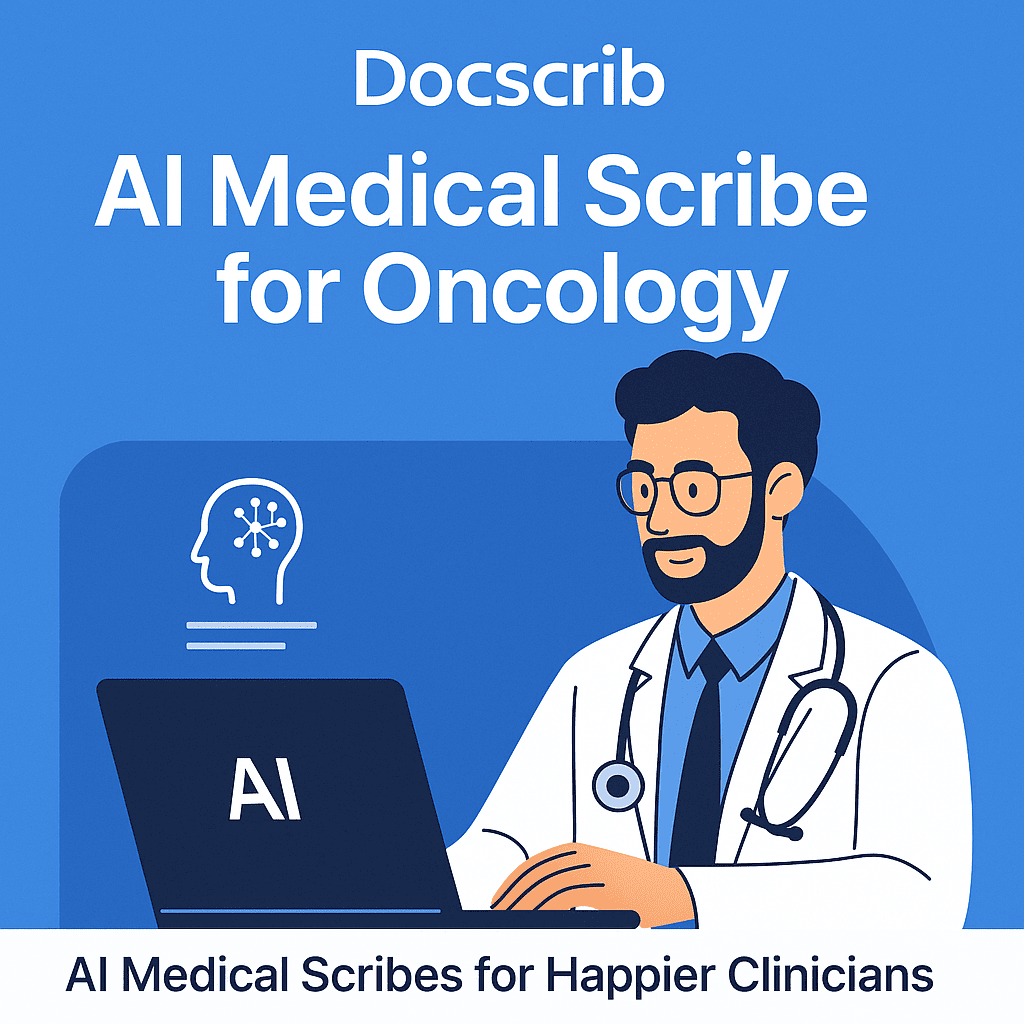Updated on: July 2, 2025
Oncology is one of the most emotionally and medically demanding specialties in healthcare. From managing multifaceted treatment plans and chemotherapy regimens to navigating sensitive conversations with patients and families, oncologists operate at the intersection of science and compassion.
But amidst all this, there’s an invisible time sink stealing hours from clinicians every day: clinical documentation.
Whether you’re writing progress notes, infusion summaries, staging reports, or multidisciplinary care plans, the EHR burden in oncology is real—and growing.
That’s where AI medical scribes for oncology come in.
DocScrib is a next-generation AI-powered scribe solution tailored to oncology workflows. It listens, understands, and documents your patient encounters in real time—so you can focus more on healing, and less on typing.
💬 The future of oncology documentation is here—and it’s ambient, accurate, and built to support happier clinicians.
Why Documentation in Oncology Is Uniquely Challenging
Oncology is documentation-heavy by nature. Providers must record:
-
Detailed diagnostic histories and staging
-
Molecular pathology and biomarker data
-
Evolving treatment protocols (chemo, radiation, immunotherapy)
-
Pain and symptom assessments
-
Psychosocial and palliative considerations
-
Multi-specialty collaboration notes
Oncologists often spend 2–3 hours daily inputting data manually into the EHR. It’s not just exhausting—it increases the risk of error, reduces time with patients, and contributes significantly to burnout.
What Is an AI Medical Scribe for Oncology?
An AI medical scribe like DocScrib uses advanced voice recognition and natural language processing to capture the spoken clinical encounter and generate accurate, structured medical notes.
Unlike general voice transcription tools, DocScrib is trained on oncology-specific terminology, protocols, and workflows—producing documentation that’s both clinically relevant and billing-ready.
Whether you’re reviewing scan results, discussing prognosis, or planning adjuvant therapy, DocScrib transcribes, organizes, and formats the note in real time.
How Docscrib Transforms Oncology Practice
1. Real-Time Ambient Documentation
DocScrib listens to the conversation during the visit and writes the note as you speak, without interrupting the patient interaction.
🩺 Example:
“The patient is a 62-year-old with stage IIIb non-small cell lung cancer, responding well to pembrolizumab. Next CT due in 6 weeks. ECOG performance status remains 1.”
DocScrib converts this into:
-
HPI: Responding to immunotherapy, stable disease.
-
Assessment: NSCLC Stage IIIb, no progression.
-
Plan: Continue pembrolizumab; CT in 6 weeks.
All automatically formatted and ready to drop into your EHR.
2. Oncology-Specific Terminology and Context
DocScrib is purpose-built to understand complex oncology concepts like:
-
TNM staging
-
ECOG/Karnofsky performance scales
-
Chemo/immuno regimens
-
Genetic markers (e.g., BRCA, EGFR, ALK)
-
RECIST response criteria
-
Survivorship and palliative care pathways
This ensures your documentation is not only fast—but accurate and oncology-appropriate.
3. Reduced After-Hours Charting and Burnout
With documentation happening during the visit, you don’t need to stay late finishing notes.
⏱️ Clinicians using DocScrib report saving up to 2 hours per day, significantly reducing after-hours work and boosting job satisfaction.
4. Enhanced Communication and Collaboration
In cancer care, seamless communication across specialties is vital. With clean, consistent notes generated in real time, care teams can:
-
Review treatment history quickly
-
Coordinate with radiologists, surgeons, palliative care
-
Improve handoffs between outpatient and inpatient oncology
-
Avoid redundant testing and treatment gaps
Docscrib vs Other AI Medical Scribes
| Feature | DocScrib | Soaper | NoteMD | Freed | ChartNote |
|---|---|---|---|---|---|
| Oncology-specific NLP | ✅ Yes | ❌ No | ❌ No | ❌ Partial | ❌ General |
| Real-time ambient documentation | ✅ Yes | ✅ Partial | ❌ No | ✅ Yes | ❌ Manual |
| Integration with EHRs | ✅ Seamless | ❌ No | ✅ Yes | ✅ Yes | ✅ Yes |
| HIPAA & SOC 2 compliance | ✅ Yes | ✅ | ✅ | ✅ | ✅ |
| Oncology terminology + protocols | ✅ Deep | ❌ No | ❌ No | ❌ No | ❌ No |
🎯 Ready to see how DocScrib works in an oncology workflow?
👉 Book a personalized demo now →
Is DocScrib Secure for Oncology Data?
Absolutely. Oncology patients entrust you with their most sensitive health information. We take that seriously.
-
✅ HIPAA-Compliant
-
✅ SOC 2 Type II Certified
-
✅ End-to-End Encryption
-
✅ No data stored without explicit consent
Frequently Asked Questions
❓ Will I still control my notes?
Yes. You review and approve each note. You can edit for tone, clinical nuance, or billing preferences.
❓ Does it work for chemotherapy and infusion centers?
Yes. DocScrib can generate infusion visit notes, pre-medication logs, adverse event tracking, and post-chemo assessments.
❓ What about multidisciplinary tumor board notes?
DocScrib can help capture summaries during collaborative care meetings—streamlining follow-ups and action items.
How to Get Started with Docscrib
You don’t need to change your EHR, install hardware, or train staff.
-
Visit docscrib.com
-
Request an oncology-specific demo
-
Start a free trial with customized onboarding
-
See time saved on Day 1
🛠 Works with your EHR. Built for your workflow. Loved by oncology teams.
👉 Book Your Free Docscrib Demo Now →
Final Thoughts: AI Scribes Are the Future of Oncology Documentation
In oncology, you don’t just treat disease—you navigate some of the most personal, complicated care journeys in medicine. That kind of work deserves tools that support you—not slow you down.
With AI medical scribes in oncology, Docscrib gives you back your time, clarity, and control. So you can spend less time typing, and more time listening, comforting, diagnosing, treating—and leading.
Because cancer care is too important to be interrupted by clicks and keystrokes.
